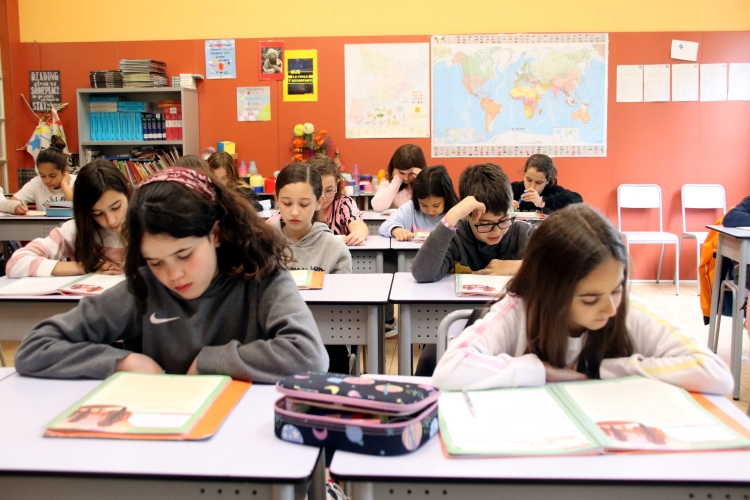All set for new school year: earlier start, no strikes, no 25% Spanish quota, fewer students
No Covid measures for first time in three years while daycare for 2-year-olds will be free

Children are back to school on Monday after a long and hot summer break that lasted just under two and a half months – they cannot claim to not have rested enough, but it will be the first time they've ever had a week less than usual off.
The education ministry announced summer vacation would be shorter in February, leading to teachers' complaints.
Indeed, department authorities had an eventful few months ahead of the 2022-2023 school year – including an open conflict with unions for several issues, some stemming from post-2008 financial crisis budget cuts, and a legal dispute to safeguard the Catalan language immersion system in classrooms.
Yet, in the eleventh hour, all has been sorted – at least for now. Here is all you need to know about the 'tornada a l'escola':
Sept 5 to 7: earlier start
Preschool and primary school children (those aged 3 to 12) begin lessons on September 5 this year, but during the whole month of September, they will only go to school in the morning although lunch will be provided to those who request it.
On September 7, it will be time for those in secondary school (aged 12 to 16), Batxillerat pre-university programs (16 to 18), and professional training courses.
This affects all schools, including public, semi-private and private.
With this shift, the Catalan government aims to help improve families' work-life balance and "narrow the gap between school years." This was also done with low-income families in mind, as some parents may not be able to afford summer activities for their kids to do while they are at work.
Yet, teachers' unions did not agree with the measure, leading to numerous strikes in the spring that failed to achieve a government U-turn.
No teacher strikes, for now
Unions had called more demonstrations at the start of this academic year – including the very first day of lessons for secondary school students, September 7 – to ask for better work conditions.
Yet, this Thursday, staff representatives reached a significant deal with the Catalan education ministry for which professionals will teach an hour less from January 2023, something that was a long-standing demand ever since budget cuts increased their instruction time by an hour a decade ago.
Primary school teachers will teach 23 hours a week, while secondary school ones will teach 18. This will mean that 3,500 more teachers will have to be hired, costing a total of €170m.
Unions unanimously signed the agreement, but "this does not mean that the academic year will end without any strikes," said USTEC union spokesperson Iolanda Segura. Other complaints – some dating back to the post-2008 era – are still lacking a deal, with teachers setting an end-of-2022 deadline for them to be met.
No 25% Spanish imposed quota, yet
After a long-lasting legal battle between the Catalan education ministry, Spanish-speaking parents' associations, and the judiciary, the Spanish Supreme Court ruled in November 2021 that a 25% Spanish language in teaching quota had to be introduced.
Catalonia has had a four-decade-long policy of language immersion, i.e. teaching in Catalan. As Spanish is the dominant language in the media and online, the education policy is designed to protect the Catalan language, ensure bilingualism, and prevent the creation of separate language communities.
A legal move including a new government decree and a law approved by parliament has been Catalonia's most recent strategy to stop the ruling – and so far, it has worked.
On Thursday, Gonzàlez-Cambray announced that no schools will have to apply any quotas this year, and Catalonia's high court has temporarily barred this possibility.
Yet, this is only because it has taken the new law and decree to the Constitutional Court, which will at some point have to rule on their legality, deciding whether the immersion will remain in place or whether the 25% quota needs to be applied.
Fewer students due to demographics, but more teachers
1,588,733 students are expected to enroll and attend lessons this year, some 5,000 fewer than last.
Yet, there will be 1,112 more teachers in September than last year, hitting the 76,406 mark – approximately one per every 20 children.
Indeed, this figure is the authorities' target and most pre-school P-3 classrooms (3-year-olds) are expected to have no more than 20 students each. The plan is to steadily introduce this threshold in the coming years to all primary school grade levels.
By January 2023, 30,000 permanent posts for teachers already working on temporary contracts will open.
Free schooling for 2-year-olds
The Catalan government is guaranteeing, for the first time ever, free daycare for 2-year-olds from September in pre-schools owned by local councils.
It also aims to fully reach this goal for the entire pre-school stage (0-3) in the coming years. "We begin the path to universal pre-school from 0 to 3 years," said Gonzàlez-Cambray.
More funding and benefits have been allocated to private pre-schools.
New curriculum
A new curriculum will be introduced for the odd grade levels (1st, 3rd, 5th in primary school, and 1st and 3rd in secondary school), while even ones will see it implemented in 2024.
Núria Mora, the education transformation secretary, said on Thursday that "teachers, educators, and research groups have been able to participate" in the comprehensive guidelines on what should happen in a classroom, times, and what to learn.
This stems from the new Spanish education law and, while the curriculums are still being drafted, they will begin to be applied this year.